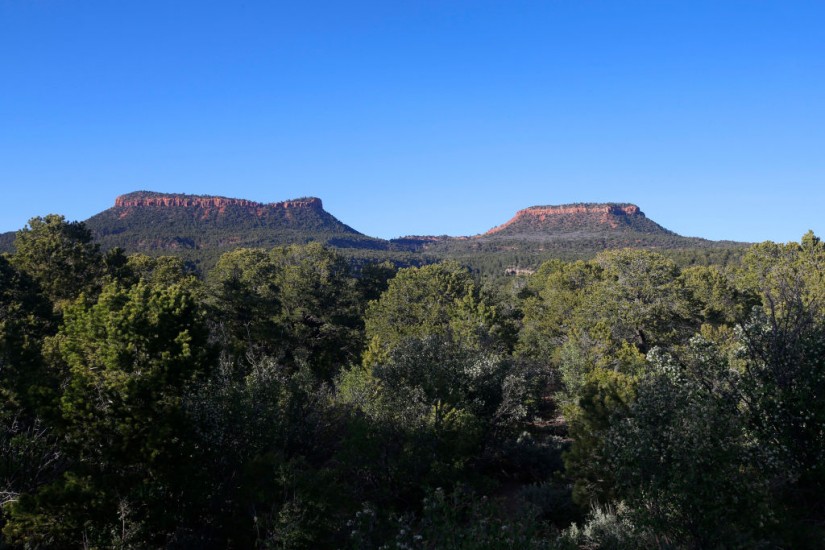President Trump recently revealed that he will substantially shrink Bears Ears National Monument, a million-plus acre tract of federal land in Utah that had been protected by President Obama. Trump will reportedly be traveling to Utah in December to make the formal announcement.
This move is hardly a surprise. Trump made his views on the subject clear when he first initiated a review of the monument’s protected status, describing it as a “massive federal land grab.” “Today we’re putting the states back in charge,” he crowed. “It’s a big thing.”
Trump’s announcement likely warmed the hearts of Utah’s political leaders, who have long demanded the “return” of federal lands to state control. In 2012, Utah enacted a law purporting to mandate this transfer — a statute cited by Ammon Bundy to defend his armed occupation of a national wildlife refuge in Oregon.
But this argument has two big flaws. First, the states were never “in charge” of these lands in the first place. The “Founders” that conservatives purport to revere explicitly determined that the federal government, not the states, would control public lands in the West. The Constitution gives the federal government power over “Property belonging to the United States.” Beginning in 1812, Congress required nearly every new state — including Utah — to foreswear all rights to federal land upon admission.
But the second flaw concerns the way the fight over Western lands is painted — as yet another competition between states representing local interests and a distant, overbearing federal bureaucracy. In fact, as Bears Ears highlights, the question of federal lands has always involved another group of locals decidedly not represented by states: Native nations, whose land ownership predates the United States and who had their lands stripped by the federal government and the states.
Most Americans are vaguely familiar with the long history of broken treaties between the federal government and Native Americans. They’re probably less familiar with the role that states played in taking Native American lands, which the federal government tried, fitfully and ineffectually, to stop.
Nowhere did this process play out more clearly than in Tennessee, the first federal territory to become a state. Led by the state’s first congressman — Trump’s self-appointed ideological doppelganger, Andrew Jackson — Tennessee insisted it alone owned all public land within its borders, including land still owned by the Cherokees. To shore up these claims, Tennesseans also began settling on disputed lands.
The federal government disagreed with Tennessee. George Washington had made treaties with the Cherokee Nation guaranteeing them the contested lands. One of the very first laws Congress enacted under the new Constitution criminalized settlement on Native American land. To enforce this statute, John Adams sent soldiers to remove the more than 2,500 Tennesseans illegally living on Cherokee land. Violence ensued, as the so-called “intruders” killed army horses and wounded a soldier.
Tennesseans were predictably apoplectic. Jackson called the federal actions “Military Tyranny.” Congress continued to insist on its right to the lands, but, to appease the Tennesseans, it browbeat the Cherokees into a treaty of cession. Expelled intruders swarmed the ceded lands.
These early conflicts established a pattern. Tennesseans flouted federal law and intruded on Native land — only to turn around and demand federal protection whenever Native Americans fought back. Some federal officials sought to enforce tribal rights, but they were rarely willing to alienate their own citizens for the Cherokees’ sake. Meanwhile, the Cherokees were forced to cede ever more land that squatters had already effectively taken over.
This process persisted for nearly 40 years, establishing precedents that culminated in the 1830s. Defying a Supreme Court decision enforcing Native rights under federal law, now-President Andrew Jackson expelled the Cherokees and other Native American nations as part of the tragic Trail of Tears. The Southern states eagerly carved up the “vacant” lands left behind.
The current struggles over public lands echo these early conflicts. Like the early Cherokees, tribes must still rely on the federal government to vindicate their rights. As the fight over the Dakota Access pipeline shows, this is particularly true because, after centuries of dispossession, many of the tribes’ historical and sacred sites are located on land formally owned by the federal government.
Bears Ears National Monument represents an important new step in cooperation between Native Americans and the federal government. The impetus for the monument came from a council of five Southwestern tribes, who persuaded President Obama to use his authority under the Antiquities Act to place additional safeguards on these federal lands in order to preserve ancestral tribal sites. Under the terms of Obama’s proclamation, this council will cooperate with federal agencies to craft and administer a management plan.
Yet the older models sidelining Native peoples and their interests still persist. Despite making several trips to the region, Trump administration officials reportedly failed to consult the council when determining the monument’s future.
For its part, Utah has embraced the rhetoric of states’ rights against federal overreach, just as Tennessee once did. But their attempt to frame the dispute as a question of federalism should not obscure the real issue. Just as it was two centuries ago, the argument for state control is actually a claim that some locals should determine the land’s future at the expense of other locals — the Native nations that have lived there for millennia.
Tennessee’s cynical arguments culminated in removal, and Trump seems eager to ape Jackson in harming Native American interests. But Congress and the American people can choose a different course and honor the rights the nation long ago promised Native Americans, even in the face of state opposition.
